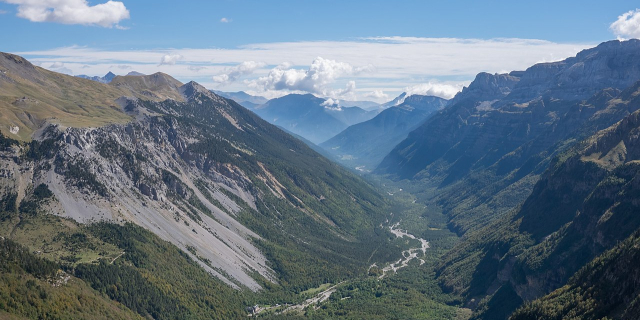The Sanctuary of Our Lady of Lourdes (French: Sanctuaire de Notre-Dame de Lourdes; Occitan: Santuari de Nòstra Senhora de Lorda) is a Catholic Marian shrine and pilgrimage site dedicated to Our Lady of Lourdes in the town of Lourdes, Hautes-Pyrénées, France. The sanctuary includes several religious buildings and monuments around the grotto of Massabielle, the place where the events of the Lourdes apparitions occurred in 1858, among them three basilicas, the Basilica of Our Lady of the Immaculate Conception, the Rosary Basilica and the Basilica of St. Pius X, respectively known as the upper, lower and underground basilica.
The sanctuary is a destination for sick and disabled pilgrims, as the Lourdes water, which has flowed from the grotto since the apparitions, is reputed for miraculous healings. The area is owned and administered by the Roman Catholic Diocese of Tarbes-et-Lourdes, and has several functions...Read more
The Sanctuary of Our Lady of Lourdes (French: Sanctuaire de Notre-Dame de Lourdes; Occitan: Santuari de Nòstra Senhora de Lorda) is a Catholic Marian shrine and pilgrimage site dedicated to Our Lady of Lourdes in the town of Lourdes, Hautes-Pyrénées, France. The sanctuary includes several religious buildings and monuments around the grotto of Massabielle, the place where the events of the Lourdes apparitions occurred in 1858, among them three basilicas, the Basilica of Our Lady of the Immaculate Conception, the Rosary Basilica and the Basilica of St. Pius X, respectively known as the upper, lower and underground basilica.
The sanctuary is a destination for sick and disabled pilgrims, as the Lourdes water, which has flowed from the grotto since the apparitions, is reputed for miraculous healings. The area is owned and administered by the Roman Catholic Diocese of Tarbes-et-Lourdes, and has several functions, including devotional activities, offices, and accommodation for sick and disabled pilgrims and their helpers. In addition to the grotto and the three basilicas, the sanctuary includes fountains providing Lourdes water, baths for immersion in the water, an esplanade for processions, a calvary, the offices of the Lourdes Medical Bureau, and several places of worship in a 52-hectare (130-acre) area.
The sanctuary of Lourdes is one of the most-visited Catholic shrines in the world, with around four million tourists coming every year. The grotto of Massabielle, which is the most famous site in the sanctuary, has hundreds of replicas around the world, known as "Lourdes grottos".
The sanctuary of Our Lady of Lourdes began with the Marian apparitions to Bernadette Soubirous in 1858 in the town of Lourdes. On 11 February 1858, a 14-year-old peasant girl, called Bernadette Soubirous, said she saw a "lady" while playing near the grotto of Massabielle (from masse vieille: "old mass") with her sister and a friend, on the left bank of the Gave de Pau river.[1] The "lady" was standing on a rose bush in a niche above the main cavity of the Massabielle grotto.
At the time of the apparitions, the grotto lay well outside town, on common ground which was used by the villagers variously for pasturing animals, collecting firewood, and as a garbage dump, and it had a reputation for being an unpleasant place.[2]
Bernadette told her sister not to tell their parents about the apparition, but she told them anyway and their parents forbid them to go to the grotto again. Bernadette ignored their orders and kept going to the grotto. From 11 February to 16 July 1858, Bernadette saw the same vision 18 times. The "lady" eventually introduced herself to Bernadette as the Immaculate Conception, which had been proclaimed as a dogma for the Virgin Mary by Pope Pius IX in 1854. This convinced local priest Dominique Peyramale that Bernadette saw an authentic apparition of the Virgin Mary.
During the apparitions, Bernadette was given instructions by the "lady", which were to prove central in the development of the sanctuary and its ceremonies. Bernadette was told to go and drink water from a spring which was to appear inside the grotto and wash herself with it. She was also told to go and tell the priests to build a chapel at the grotto site where people were to come in procession.
During the months after the apparitions, public interest in the apparitions grew, and curious visitors began to be replaced by pilgrims from increasingly far away, drawn by compelling stories of apparitions and miracles.
Local priest Dominique Peyramale and local bishop Bertrand-Sévère Laurence bought the grotto and the land around it from the town of Lourdes in 1861, three years after the apparitions. Immediately they set about modifying the area to make it more accessible to pilgrims, and started work to build the first of the churches, which is now known as the "Crypt".
In 1864, the French sculptor Joseph-Hugues Fabisch was commissioned to create a statue of Our Lady of Lourdes based on Bernadette's descriptions. Although it has become an iconic symbol of Our Lady of Lourdes, it depicts a figure which is not only older and taller than Bernadette's description, but also more in keeping with orthodox and traditional representations of the Virgin Mary. The statue rests in the niche where the Virgin appeared to Bernadette. The original wild rose bush was destroyed shortly after the apparitions by pilgrims seeking relics, but a newer one has been planted nearby.[3]
Due to French political upheaval resulting in an enforced separation of Church and State, the property and grounds of the sanctuary were confiscated from the Church and returned to the ownership of the town in 1910. The then bishop, François-Xavier Schoepfer, contested this confiscation and was permitted to rent the area of the sanctuary from the town until the outbreak of World War I in 1914.[4]
 The Sanctuary of Our Lady of Lourdes
The Sanctuary of Our Lady of LourdesLater, a visit to Lourdes by Marshal Pétain in 1941 provided official recognition of the sanctuary. Church officials successfully petitioned Pétain to allow the Church to reclaim ownership of the sanctuary.[4]




































Add new comment